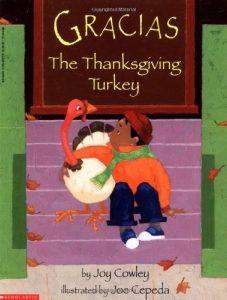 A magical train ride on Christmas Eve takes a boy to the North Pole to receive a special gift from Santa Claus.
A magical train ride on Christmas Eve takes a boy to the North Pole to receive a special gift from Santa Claus.
holidays
The Santero’s Miracle: A Bilingual Story
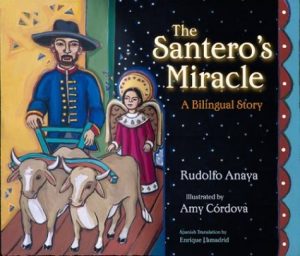 In this bilingual story of faith, Don Jacobo has a dream that, in the end, is a reminder that miracles do happen. Jacobo is teaching his visiting grandson Andrés how to become a santero. Christmas is coming, snow is falling in the village, and the two are working on a carving of San Isidro, the patron saint of farmers. The half-finished carving stands in the living room beside the two oxen and the angel that don Jacobo carved earlier in the month. The snow-covered mountains are beautiful, but the road to the village is impassable. Andrés’s parents will not be able to get to the house for the holiday, and Jacobo’s neighbor Leopoldo is desperately ill but cannot get to the hospital. Then comes Jacobo’s dream; San Isidro is plowing with the two oxen and the angel is helping. \”But we don’t plow ’til April\” don Jacobo muses upon awakening. \”What does it mean?\” The night had been bitterly cold and don Jacobo must bundle up to go to the barn to feed his cows and chickens. As he steps outside, he can hardly believe his eyes. The snow-packed road is clear. Rudolfo Anaya’s story of the power of faith, hope, and love will be enjoyed by readers of all ages.
In this bilingual story of faith, Don Jacobo has a dream that, in the end, is a reminder that miracles do happen. Jacobo is teaching his visiting grandson Andrés how to become a santero. Christmas is coming, snow is falling in the village, and the two are working on a carving of San Isidro, the patron saint of farmers. The half-finished carving stands in the living room beside the two oxen and the angel that don Jacobo carved earlier in the month. The snow-covered mountains are beautiful, but the road to the village is impassable. Andrés’s parents will not be able to get to the house for the holiday, and Jacobo’s neighbor Leopoldo is desperately ill but cannot get to the hospital. Then comes Jacobo’s dream; San Isidro is plowing with the two oxen and the angel is helping. \”But we don’t plow ’til April\” don Jacobo muses upon awakening. \”What does it mean?\” The night had been bitterly cold and don Jacobo must bundle up to go to the barn to feed his cows and chickens. As he steps outside, he can hardly believe his eyes. The snow-packed road is clear. Rudolfo Anaya’s story of the power of faith, hope, and love will be enjoyed by readers of all ages.
Americas Award For Children’s And Young Adult Literature. Commended (Awards)
Carnaval
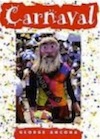
For weeks the people of the Brazilian town of Olinda have been sewing costumes, painting masks, and creating giant puppets–preparing for carnaval. Like Mardi Gras in New Orleans, carnaval is a five-day festival of parades, dancing, and singing. But unlike Mardi Gras, Olinda’s carnaval still celebrates the traditions and folklore of the people and the shared cultures–indigenous, European, and African–that make up Brazil. As generations have done each year, the people of Olinda and their visitors give themselves over to the music, dance, and joy of carnaval.
Pablo Remembers
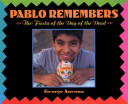
From October 31 to November 2, people in Mexico celebrate the festival of el Dia de Los Muertos, the Day of the Dead. This photodocumentary follows Pablo and his family as they prepare to honor the memory of Pablo’s grandmother. Ancona’s photographs catch the affirmation of life that fills the Mexican festival arising from both Aztec and Christian customs honoring the dead.
Gracias The Thanksgiving Turkey
N Is for Navidad
Bienvenidos! to a celebration of Christmas, Latino-style! From the ngel (angel) hung above the door to the zapatos (shoes) filled with grass for the wise men s camels, each letter in this festive alphabet introduces children to a Spanish word, and each colorful page takes them through another joyous aspect of the 22 days of the traditional holiday. Vibrant art from acclaimed illustrator Joe Cepeda beautifully complements the lively, rhythmic text to bring the reader a wealth of heritage and a season of light! Feliz Navidad!
The Christmas Gift
With honesty and rare grace, award-winning author Francisco Jiménez shares his most poignant Christmas memory in this remarkable book. Illustrated with paintings full of strength and warmth, written in spare bilingual text, this simple story celebrates the true spirit of Christmas, and illuminates how children do indeed draw strength from the bonds of their families.
Uno, Dos, Tres, Posada! Let’s Celebrate Christmas
A posada is an important Latino holiday tradition that happens all over the world on each of the nine nights before Christmas. There’s a lot to do every night before the party can begin, and here a little girl guides us through each step—from putting out poinsettias to hanging the piñata—as she counts to ten in English and Spanish. Young readers can follow along by counting the different items mentioned. An author’s note at the end of the story further explains the origins of the posada. Sprinkled with Spanish vocabulary and filled with lively illustrations, this is a posada no one should miss!
Los Gatos Black On Halloween
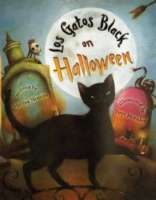
Follow los monstruos and los esqueletos to the Halloween party Under October’s luna, full and bright, the monsters are throwing a ball in the Haunted Hall. Las brujas come on their broomsticks. Los muertos rise from their coffins to join in the fun. Los esqueletos rattle their bones as they dance through the door. And the scariest creatures of all aren’t even there yet!This lively bilingual Halloween poem introduces young readers to a spooky array of Spanish words that will open their ojos to the chilling delights of the season.
Growing Up with Tamales/Los Tamales De Ana (Spanish Edition)
“My name is Ana. Every year, my family makes tamales for Christmas. This year, I am six, so I get to mix the dough, which is made of cornmeal. My sister Lidia is eight, so she gets to spread the dough on the corn husk leaves. I wish I was eight, so that my hands would be big enough to spread the dough just right–not too thick and not too thin.” And so the years pass, and Ana turns eight, ten, twelve, fourteen, sixteen. But every year, big sister Lidia is always two years older. Ana envies her elder sibling and wishes she could do what Lidia does: put just the right amount of meat inside the tamales and roll them up; steam the tamales without scalding herself with the hot, hot steam; chop and cook the meat for the tamales without cutting or burning her hands. When she turns eighteen, though, Ana knows she will keep making tamales and she will be able to do all of the steps herself in her very own factory. When Christmas comes around, Ana will deliver tamales to all of her customers around the world, in delivery trucks that say “Ana’s Tamales.” And maybe Ana will even let Lidia work for her. Gwendolyn Zepeda’s rhythmic prose is combined with April Ward’s bright illustrations to create an affectionate and amusing story about sibling relationships that introduces an important Hispanic holiday tradition–making tamales!

